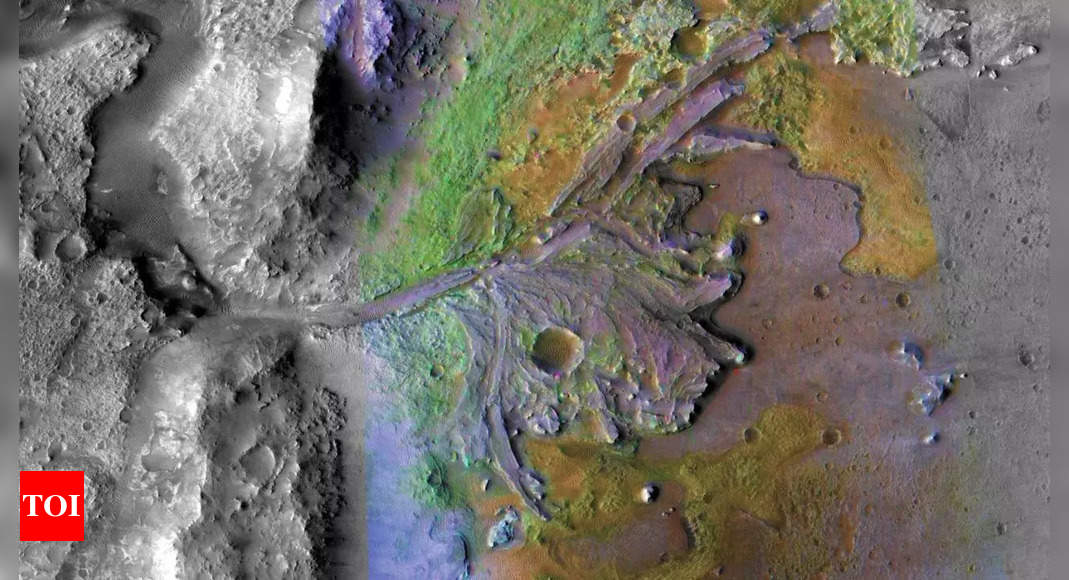
A groundbreaking study by researchers at the Physical Research Laboratory in Ahmedabad has unveiled new insights into the potential for ancient microbial life on Mars. The study focuses on chloride-rich depressions, particularly within the Terra Sirenum region, which may have once harbored water—a vital component for life as we know it. These findings are part of ongoing efforts to unravel the mysteries of Mars‘ wet history and its habitability. The study, published in JGR Planet, reveals that these depressions were likely part of an extensive sedimentary basin that experienced repeated cycles of wetting and drying, creating conditions potentially favorable for microbial life.
Chloride-rich regions on Mars: Unlocking clues to ancient water and potential life
Chloride-rich areas on Mars have long intrigued scientists due to their ability to retain moisture and the implications this has for ancient water on the planet. These deposits are believed to have formed during Mars’ early history, possibly under conditions that supported liquid water. The study highlights the geochemical significance of these chlorides:
- Moisture absorption: Chlorides can absorb and retain moisture, making them potential reservoirs of water in an otherwise arid environment.
- Microbial potential: On Earth, microbial life thrives in similar mineral-rich environments, suggesting that Martian chlorides might have once supported life.
These findings underscore the importance of chloride-rich regions in the search for biosignatures and ancient microbial ecosystems on Mars.
Discovery in Terra Sirenum region
The study zeroes in on a topographic depression in the Terra Sirenum region. Key findings include:
- Sedimentary basin: The depression is part of a vast sedimentary basin that extended beyond its current boundaries, indicating a history of water activity.
- Wetting and drying cycles: The area experienced multiple cycles of wetting and drying over thousands of years, which are known to create optimal conditions for microbial life.
- Geochemical modeling: Analysis of mineral-rich deposits shows that they were not hostile to life, as microorganisms on Earth are known to survive in even more extreme conditions.
Implications for Mars’ wet history
The study provides strong evidence that liquid water, a precursor to life, once pooled in these depressions. By studying the chemical composition and sedimentary structures of these regions, researchers have uncovered clues about Mars’ climatic past, including:
- The presence of stable water bodies in the planet’s history.
- The existence of environments capable of supporting microbial ecosystems.
These findings also add to the growing body of evidence that Mars underwent significant climatic and geological changes, transitioning from a wetter planet to its current dry state.
Potential for astrobiological exploration on Mars
The study emphasizes the astrobiological importance of chloride-rich depressions. Such regions are not only scientifically intriguing but also practical for future exploration missions. Highlights include:
- Prime locations for study: The depressions represent ideal sites for searching for biosignatures and studying Mars’ paleolake records.
- Localised investigations: The researchers stress the need for focused exploration in these areas to maximize the chances of detecting evidence of past life.
Future Mars missions
This research lays the groundwork for future missions, particularly those aimed at astrobiological investigations. Key recommendations from the study include:
- Targeting chloride-rich regions for in-situ analysis.
- Deploying advanced instruments capable of detecting organic compounds and microbial fossils.
- Incorporating these findings into the broader framework of Mars exploration, which includes missions like NASA’s Perseverance rover and ESA’s ExoMars program.
The discovery of chloride-rich depressions and their potential link to Mars’ wet history marks a significant step forward in the search for life beyond Earth. By identifying these regions as key sites for future exploration, the study offers valuable insights into Mars’ evolution and its capacity to host life. These findings not only deepen our understanding of the Red Planet but also pave the way for transformative discoveries in planetary science and astrobiology.
This latest research underscores the importance of localized studies and highlights the potential for groundbreaking revelations about our planetary neighbor. As exploration continues, Mars may yet reveal its secrets, bringing us closer to answering the age-old question: Are we alone in the universe?









